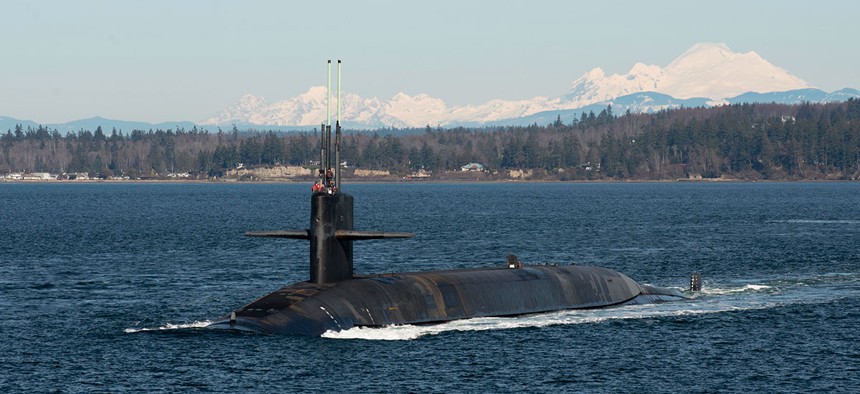
The Ohio-class ballistic-missile submarine USS Henry M. Jackson is shown in the Puget Sound on Feb. 13. Lt. Cmdr. Michael Smith/Navy
New Nuclear Delivery Platforms Will Likely Cost More than Planned. Here’s Why.
The Pentagon hasn’t purchased nuclear bombers, missiles, and subs in decades, so it’s tough to predict how much new ones will cost.
The Pentagon has gotten better at estimating the cost of new weapons, but nuclear-armed ships, subs, and missiles are entirely different animals.
Estimates of the cost to maintain and ultimately replace the current planes, rockets, and submarines that may deliver them — range from hundreds of billions of dollars to more than $1 trillion over the next three decades.
In a new report, the Defense Department’s office of Cost Assessment and Program Evaluation — considered the gold standard of budget estimators inside the Pentagon — notes that in looking at a proposed ICBM project, “it was unusually difficult to estimate the cost ... because there was no recent data to draw upon, and the older historical data was of very questionable quality or was nonexistent. This leads to considerable uncertainty and risk in any cost estimate.”
On Tuesday, the Congressional Budget Office said it will cost the departments of Defense and Energy some $400 billion over the next decade alone to buy new bombers, submarines and ICBMs. That estimate also includes the cost of maintaining current inventory of nuclear weapons and delivery systems.
But within that $400 billion figure is $56 billion in anticipated cost overruns. Those costs would be incurred “if the costs for those nuclear programs exceeded planned amounts at roughly the same rates that costs for similar programs have grown in the past,” the report states.
The estimates come as the Pentagon and defense firms prepare to build the military’s next-generation intercontinental ballistic missile. That project (along with maintaining the current Minuteman III ICBMs) is expected to cost $43 billion between 2017 and 2026, according to the nonpartisan Congressional Budget Office. The Air Force says the new ICBMs will cost $62 billion over 30 years, but the CAPE report estimates that the project will cost more than 35 percent more than service officials have said.
As well, the Congressional Budget Office estimates the 2017-26 cost of new Navy Columbia-class ballistic submarines (and maintaining the current Ohio-class subs) at $90 billion; new Air Force bombers, $43 billion. Then there’s another $58 billion needed for new command-and-control planes and improvements to early-warning satellites and $87 billion for the nuclear weapons laboratories.
That begs the question, how can the Pentagon afford it all?
“For the last three years or so, the department has been very deliberately planning for the modernization bills that we’ve known were coming as a whole suite of systems that were built decades ago are coming up on their end of life,” Jamie Morin, an Obama administration appointee who served as director of the CAPE office until last month, said in an interview shortly before he left office. “All of those programs … are pretty well understood and we have good estimates for the cost and schedule it will take to deliver them.”
But keeping them on schedule is a necessity because the current inventory, particularly the Ohio-class nuclear submarines, only have so much life left in them.
“I think the department has a pretty good handle on when we need them,” Morin said. “I think we recognize that that leaves us just about enough time to responsibly execute these recapitalization programs.”
Despite objections, the Obama administration in July took the first steps toward buying new ICBMs and a controversial long-range nuclear cruise missile, called the Long-Range Standoff Weapon. While President Donald Trump has not laid out a detailed nuclear weapons plan, in December, he tweeted: “The United States must greatly strengthen and expand its nuclear capability until such time as the world comes to its senses regarding nukes.”
The Minuteman III ICBMs date to the 1970s; the last ones were built in 1978. The long-range nuclear missiles are scattered across the north-midwestern United States in underground silos.
Boeing, which made the Minuteman III, as well as Lockheed Martin and Northrop Grumman have said they intend to bid on the new ICBM project, called the Ground Based Strategic Deterrent. The Air Force is expected to chose a winning bid later this year.
The Air Force selected Northrop Grumman to build a new stealth bomber, which will eventually carry nuclear weapons. Called the B-21 Raider, it will replace the B-1, which no longer carries nuclear weapons, and the B-52, which has been in the Air Force since the 1950s.
NEXT STORY: Did Michael Flynn Tell the FBI the Truth?







